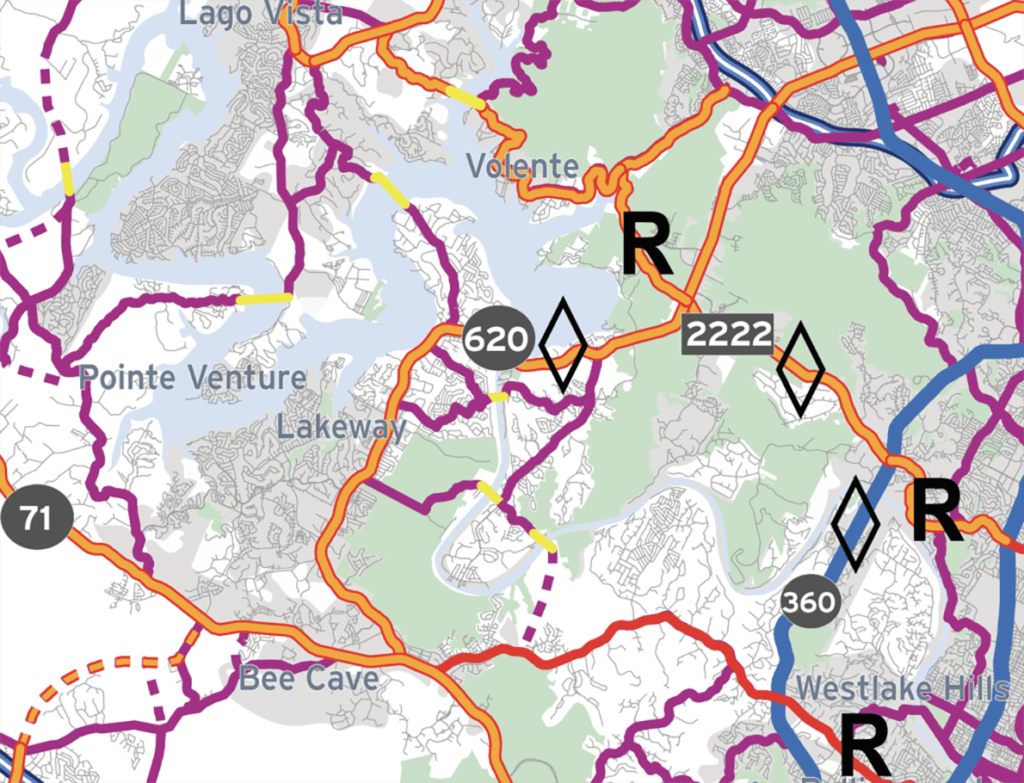
By LYNETTE HAALAND, Four Points News
The Capital Area Metropolitan Planning Organization unveiled its Regional Arterials Study at its June 10 meeting and long range roadway ideas on the CAMPO maps show Steiner Ranch could be affected.
“There is a lot of confusion about this study. The confusion was on display at the CAMPO meeting June 10 when elected officials were trying to understand the maps that CAMPO plans to display at the open houses,” stated Brian Thompto, Steiner Ranch Neighborhood Association chairman.
“Discussion at the meeting did make it clear that the maps and roadway ideas are not plans but a collection of ideas… conceptual options… intended to generate public dialogue about the good and bad options out there to connect our community based on the options shown. SRNA subsequently talked with CAMPO to confirm this is the case,” Thompto further stated in a SRNA email on June 19.
Several local residents attended the June 19 open house at Bee Cave City Hall since it is the closest one being held by CAMPO.
The CAMPO maps show roads and bridges over Lake Austin in three areas connecting Steiner Ranch to Lakeway and Bee Cave.
The keys on the CAMPO maps show Quinlan Park Road could be a principal arterial road in its Regional Arterials Study 2040 Planned Road Network.
Steiner Ranch is also on scenarios B and C with adding new, non-tolled managed lane options and regional corridors over Lake Austin.
At first appearance, there are three proposed river crossings on the maps. Lani Oglewood, communications director of Commissioner Brigid Shea, Precinct 2, stated in an email: these “would connect major highway traffic through the middle of Steiner Ranch… Neither Commissioner Shea nor Travis County staff support connecting 620 to Bee Cave through the middle of Steiner Ranch.”
The Steiner Ranch Master Association HOA board shared two email blasts during the week with strong statements against CAMPO’s ideas:
“The draft proposal will turn Quinlan into another 620 nightmares, causing significant delays during peak commute, continued stream of traffic throughout the day causing safety and security issues for broader Steiner Ranch.”
SRMA refers to the roadways as proposals, which they are actually concepts rather than proposals. The emails went onto say:
“CAMPO staff did not reach out and discuss the proposal with (the) Steiner Ranch Master board… The SRMA Board of Directors deliberated on (the) CAMPO proposal on June 14 and voted unanimously against the proposal for three arterial roads connecting Steiner Ranch to Bee Caves and Lakeway. However, Steiner Board will continue to engage Travis County and CAMPO for optimal infrastructure solution for broader Steiner Ranch.”
Former SRMA board member and Steiner resident Brad Stanton weighs in on the CAMPO maps, saying that relief is needed.
“The details aren’t clear on where exactly the larger roads would actually take place but it does provide the relief needed to the 620 corridor,” Stanton said. He adds that if the CAMPO concepts came to fruition, it would “disrupt Steiner immensely with little disruption to Lakeway which doesn’t seem to make sense.”
Stanton says he would be in favor of widening Quinlan Park Road and of a bridge over Lake Austin at the end of Quinlan.
“I do find it ironic, that the SRMA board unanimously voted against the CAMPO proposal — even though the citizens of Steiner didn’t ask them to take action — that provides relief, yet the same board advocates for route F, which they admit, might provide a 15 percent relief for residents exiting Steiner right to Four Points,” Stanton said.
Another Steiner resident shares similar thoughts.
“They (SRMA) aren’t the government body over Steiner,” Jannine Farnum said. “They are a HOA. Yes these roads would cut through SRMA property but why the quick ‘no’ on this but quick ‘yes’ for route F to be open road?”
The CAMPO Regional Arterials Study is a collection of ideas for potential improvements to the regional arterials network in the six-county area for the 2045 Plan.
All of these roadway ideas are unfunded and cannot move forward until a local government project sponsor finds funding and conducts additional analysis, detailed study, and public input, CAMPO states.

